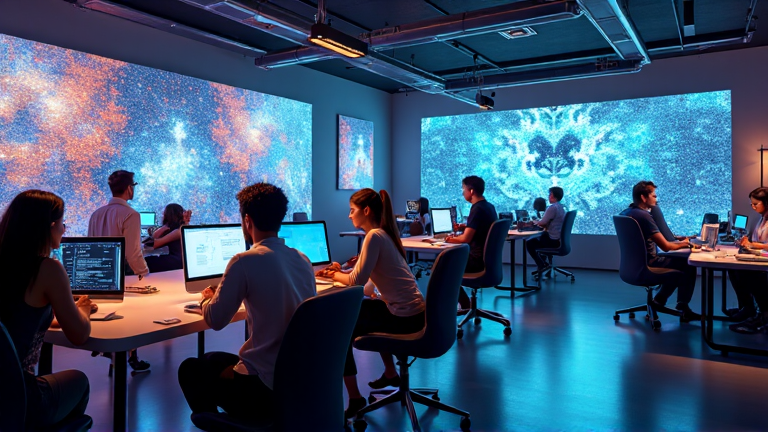
Mastering the Art of Designing for Generative AI Experiences
Embracing Specific Skills for AI-Driven Interfaces
Graduate school marked the beginning of a profound journey into the realm of artificial intelligence for one particular individual. The introduction to AttGAN, a method used in machine learning to enhance image detail and realism, sparked an unyielding curiosity. Over five years, the evolution of AI has been nothing short of extraordinary, with vast improvements in image quality, representation, style, and detail.
Now serving as a senior experience designer with Adobe Design’s Machine Intelligence New Technology (MINT) team, these technological advancements have coincided with a shift in user expectations. Today's digital product users seek seamless interactions, personalized suggestions, and adaptive systems that acknowledge and satisfy their personal demands and comprehension.
This shift represents both a need and an opportunity for UX designers: moving from designing static interfaces to crafting experiences that are natural, intuitive, personalized, and human-centered. To achieve this, designers must emphasize key skills that enhance user connection and satisfaction.
The Essential Role of Design in AI
AI excels in various tasks such as detection, pattern recognition, classification, prediction, and providing recommendations based on user behavior. It is capable of generating text, images, videos, and audio by integrating informational fragments into innovative creations.
Despite these capabilities, AI struggles with nuanced aspects of human interaction like emotion and cultural context. It often lacks the ability to fully understand the unique intricacies of new data. Designers must, therefore, focus on creating interfaces that foster a harmonious relationship between users and AI, allowing these elements to evolve together and enhance one another:
- Users provide crucial feedback and insights that drive AI development.
- Designers use this feedback to amplify the value AI solutions bring, ensuring they align with user needs.
- As AI technology advances, user experiences are adapted to offer enriched interactions and more personalized, contextually relevant solutions.
Key Responsibilities of AI Designers
Creating a meaningful AI experience involves more than just developing models; it requires making them approachable and valuable. Designers play a critical role in facilitating control, personalizing interactions, and building trust.
Empowering Users with Control
In AI design, supporting user choices and decisions is paramount. Adobe Firefly exemplifies this approach by transforming potentially intimidating interfaces into approachable experiences. Its prompt interface allows users to input ideas akin to a web search.
To alleviate creative barriers and increase agency over image generation, tools such as a panel with controls, presets, and parameters guide users in refining both prompts and their resultant images. Displaying style options and visual references empowers users of all levels, fostering creative exploration and ownership.
Tailoring and Contextualizing Experiences
Users now demand experiences that are tailored to their unique needs and contexts. Understanding a user’s environment and adapting the experience accordingly is crucial.
Features like Photoshop’s contextual task bar or Generative Fill harness AI’s predictive capabilities to adjust content dynamically based on contextual signals. Multi-modality and dynamic interactions offer flexible, vibrant experiences tailored to individual user preferences and skills.
Fostering Understanding and Trust
Building empathy between users and AI models involves improving AI's explainability—providing clear rationales for decisions. For instance, Firefly’s Style reference feature uses design elements to clarify AI contributions, offering guidance such as onboarding tours and data usage transparency.
Reducing jargon, aligning explanations with user expectations, and designing robust feedback systems build trust in AI systems, allowing users to navigate errors with confidence. Effective feedback loops in designs like Firefly encourage continual refinement, enhancing model quality and reliability.
Soft Skills Needed for Designing AI Experiences
While empathy remains central to UX, designers working with AI require additional skills to thrive:
- Embrace Ambiguity: AI's evolving landscape demands agility and openness to experimentation as user insights shape intuitive experiences.
- Curiosity: A continuous exploration of AI tools and engagement with innovative communities fortifies understanding at the intersection of technology and creativity.
- Adaptability: Rapid changes in AI capabilities necessitate quick pivots, collaboration, and integration of new models and data.
- Forward Thinking: Designers are tasked with anticipating future trends and utilizing emerging technologies to exceed current expectations.
- Systems Thinking: A holistic approach ensures that design decisions contribute to a seamless and ethical ecosystem.
Expanding Experience Design Practices for AI
The accelerating growth of AI is sparking demand for designers equipped for this novel field. UX skills form a solid foundation, but designers should also grasp AI fundamentals and underlying mechanisms. Steps to transition into AI design include:
- Boost Data Literacy: Understanding data science concepts bridges the gap between design and technical teams.
- Engage Practically: Delve into AI platforms for hands-on learning through projects.
- Network within AI Communities: Exchange ideas with like-minded professionals to stay informed.
- Foster Collaboration: Work alongside multidisciplinary teams to fuse design and technology seamlessly.
As AI embeds further into digital landscapes, designers adept at these human-centered skills will not only meet the demand but will also push the boundaries of how personalized and intuitive AI experiences can become.
Note: This publication was rewritten using AI. The content was based on the original source linked above.